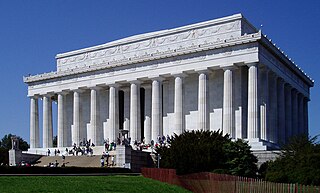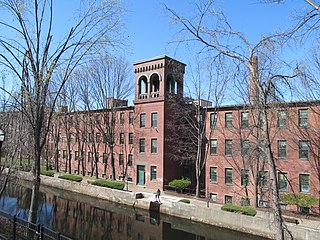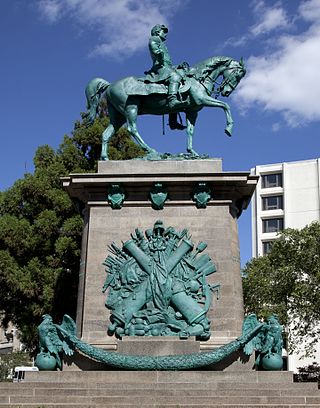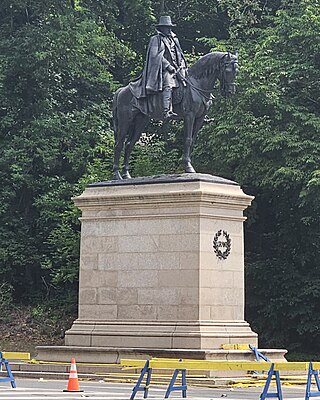
Daniel Chester French was an American sculptor of the late nineteenth and early twentieth centuries. He is best known for his 1874 sculpture The Minute Man in Concord, Massachusetts, and his 1920 monumental statue of Abraham Lincoln in the Lincoln Memorial in Washington, D.C.

Felix Weihs de Weldon was an American sculptor. His most famous pieces include the United States Marine Corps War Memorial in the Arlington National Cemetery, Virginia, US, and the Malaysian National Monument (1966) in Kuala Lumpur.
An equestrian statue is a statue of a rider mounted on a horse, from the Latin eques, meaning 'knight', deriving from equus, meaning 'horse'. A statue of a riderless horse is strictly an equine statue. A full-sized equestrian statue is a difficult and expensive object for any culture to produce, and figures have typically been portraits of rulers or, in the Renaissance and more recently, military commanders.

Edward Clark Potter was an American sculptor best known for his equestrian and animal statues. His most famous works are the marble lions, nicknamed Patience and Fortitude, in front of the New York Public Library Main Branch

Henry Bacon was an American Beaux-Arts architect who oversaw the engineering and design of the Lincoln Memorial in Washington, D.C., built between 1915 and 1922, which was his final project before his 1924 death.

Baron Pietro Carlo Giovanni Battista Marochetti was an Italian-born French sculptor who worked in France, Italy and Britain. He completed many public sculptures, often in a neo-classical style, plus reliefs, memorials and large equestrian monuments in bronze and marble. In 1848, Marochetti settled in England, where he received commissions from Queen Victoria. Marochetti received great recognition during his lifetime, being made a baron in Italy and was awarded the Legion of Honour by the French government.

Ames Manufacturing Company was a manufacturer of swords, tools, and cutlery in Chicopee, Massachusetts, as well as an iron and bronze foundry. They were a significant provider of side arms, swords, light artillery, and heavy ordnance for the Union in the American Civil War. They also cast several bronze statues, which can be found throughout New England.

Abraham Lincoln – also known as The Gettysburg Lincoln – is a bronze statue of President Abraham Lincoln by Daniel Chester French, located on the grounds of the Nebraska State Capitol. The monument was commissioned by the Abraham Lincoln Memorial Association of Lincoln, Nebraska, and produced in 1912.

Major General George B. McClellan is an equestrian statue in Washington, D.C. that honors politician and Civil War general George B. McClellan. The monument is sited on a prominent location in the Kalorama Triangle neighborhood due to efforts made by area residents. The statue was sculpted by American artist Frederick William MacMonnies, a graduate of the École des Beaux-Arts whose best known work is a statue of Nathan Hale in New York City. MacMonnies was chosen to design the statue following a lengthy competition organized by a statue commission, led by then Secretary of War William Howard Taft. The monument was dedicated in 1907, with prominent attendees at the ceremony including President Theodore Roosevelt, New York City mayor George B. McClellan Jr., politicians, generals and thousands of military personnel.

Major General Marquis Gilbert de Lafayette is a statue in the southeast corner of Lafayette Square, in Washington, D.C., near the junction of Pennsylvania Avenue with Madison Place and close to the White House. The statue was erected in 1891 to honor Gilbert du Motier, Marquis de Lafayette and his contribution in the American Revolutionary War. The square, originally part of the President's Park, was named in honor of the Marquis in 1824. The statuary was made by Alexandre Falguière and Antonin Mercié, and the architect who designed the marble pedestal was Paul Pujol..

Gilbert du Motier, Marquis de Lafayette (1757–1834), a French aristocrat and Revolutionary War hero, was widely commemorated in the U.S. and elsewhere. Below is a list of the many homages and/or tributes named in his honor:

Lewis Cass is an 1889 marble sculpture by Daniel Chester French of the soldier, diplomat and politician that the state of Michigan donated as their first statue to the National Statuary Hall Collection in Washington, D.C., United States.

An equestrian statue of Joseph Hooker is installed outside the Massachusetts State House, facing Beacon Street in Boston, in the United States.

An equestrian statue of Paul Revere by Cyrus Edwin Dallin is installed at Paul Revere Mall near the Old North Church in Boston, Massachusetts.

Daniel Chester French (1850–1931) was an American sculptor who was active in the nineteenth and twentieth centuries. He was born in Exeter, New Hampshire, to Anne Richardson French and Henry Flagg French on April 20, 1850. His father, a polymath, was a judge and college president who popularized the French drain. In 1867, the family moved to Concord, Massachusetts, and French enrolled at the Massachusetts Institute of Technology. French did not perform well academically and, after a year, he left the college and returned to Concord where he first learned sculpture while attending art classes with Louisa May Alcott. Between 1869 and 1872, French studied anatomy with William Rimmer, and in 1870 he undertook a one-month apprenticeship with the sculptor John Quincy Adams Ward. After completing The Minute Man in 1875, French studied sculpture in Florence, Italy, for a year, during part of which he worked out of Thomas Ball's studio.

The equestrian statue of Charles Devens is a public monument in Worcester, Massachusetts, United States. Located in front of the old Worcester County Courthouse in the Institutional District, the equestrian statue honors Charles Devens, who served as a general in the Union Army during the American Civil War and later served as United States Attorney General. The statue was designed by Daniel Chester French and Edward Clark Potter and was dedicated on July 4, 1906.

The equestrian statue of Ulysses S. Grant is a public monument in Philadelphia, Pennsylvania, United States. Located in Fairmount Park, the monument honors Ulysses S. Grant, who served as a general in the Union Army during the American Civil War and later as President of the United States. The monument was designed by Daniel Chester French and Edward Clark Potter and consists of an equestrian statue atop a pedestal. The statue was dedicated in 1899.
















